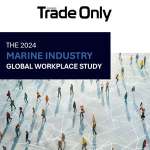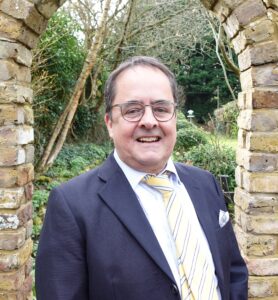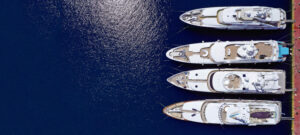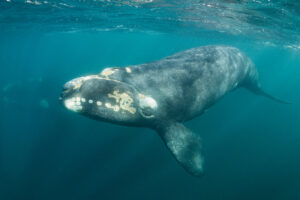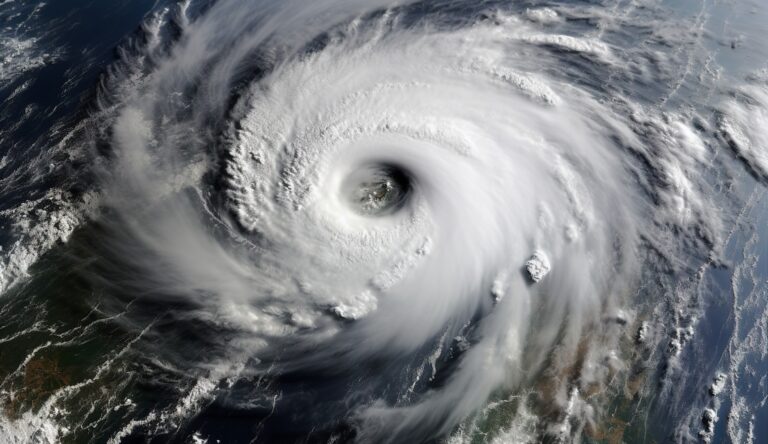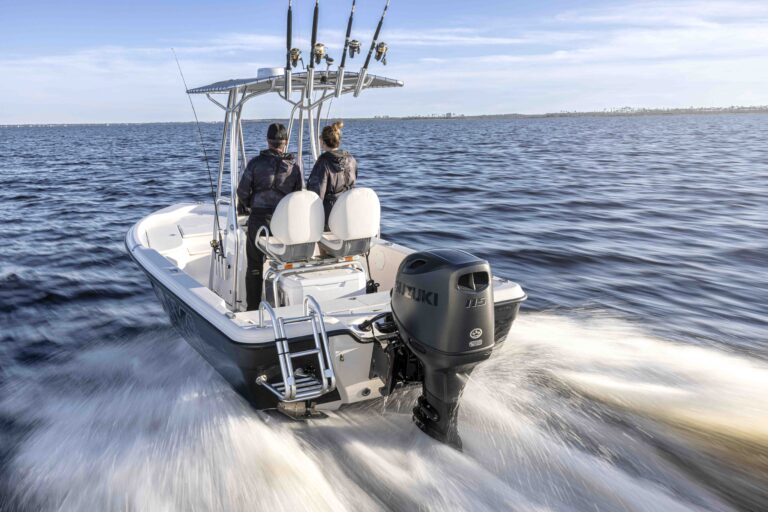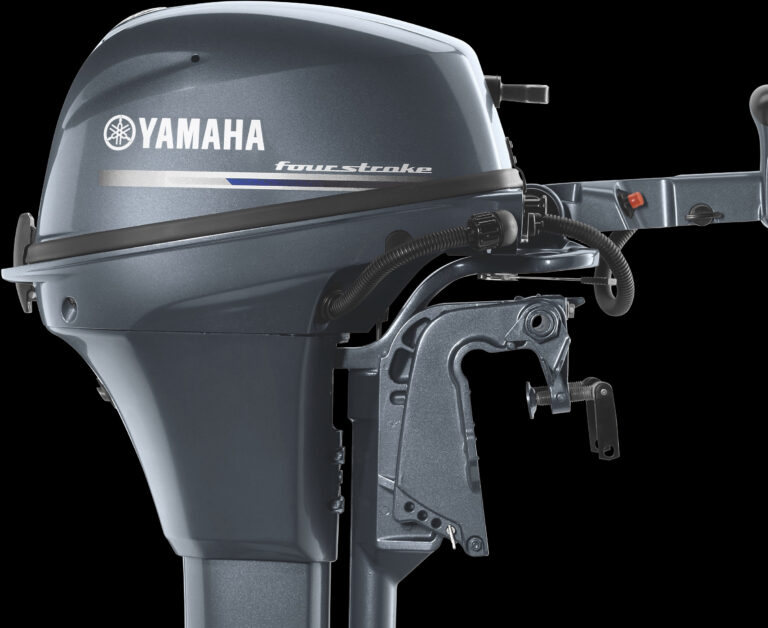
William Walton III, assistant vice president for Honda Marine, leads the development of overall strategic business direction and vision for the company. He is also charged with resource allocation and profit and loss planning for the company’s marine business in the United States.
That’s pretty good when you consider that this is his first job in the marine industry.
While many people in executive positions at boat- or engine-manufacturing companies grew up in the business, Walton spent 19 years working his way up through the ranks of Honda’s automotive division. He was appointed to his current position on October 1, 2016. Under his watch, the company has introduced 14 new or refreshed outboard motors. Some have simple color changes. Others, like the BF200, BF225 and BF250 that Walton presented at the Progressive Miami International Boat Show in February, are all-new platforms.
A self-described Air Force brat, Walton grew up in a military family, living much of his young life in Tucson and Phoenix, Ariz., and Las Vegas, places not exactly known as boating hot spots. Today, he and his wife of nine years have two children, ages 8 and 5. The family lives in Alpharetta, Ga., where they get out on the water whenever they can.
Q: How was the Miami show?
A: Miami went very well for Honda Marine. We judge this by the amount of floor traffic that we had, the amount of demo rides we gave out, and media pickup on the stories and the product that we’re offering. When we look at our total marketing opt-in, collecting information, the customer saying, “Yes, please send me more information on Honda Marine,” we were up 324 percent over last year, and our demo rides were up 983 percent over 2017, so that was a tremendous lift for us. The momentum is being carried from 2017 into 2018, so we’re really excited about it.
Q: Do you attribute the enthusiasm to the new models you introduced at the show?
A: It’s definitely introduction of new Honda Marine product but then also consistent messaging out to the public. We’ve been quiet over the last couple of years, and now we’re starting to turn that back on, and I think that’s being recognized by the industry. We’re doing exactly what we needed to do, providing customers with refreshed and new products, and it’s translating into greater interest in our products, so we’re really happy about that.

Q: The BF200, BF225 and BF250 are refreshed models for 2018. What’s new about the motors?
A: Refreshed means new features, new components, refreshed styling. On the 200-hp and 225-hp models, we moved the 3.6-liter platform down to them, so there’s some performance gain in propeller thrust and torque output in those models. Across the 200, 225 and 250, we improved maintenance on all of them because we hear from our dealers that it’s hard to find and keep good technicians. That’s not unlike the automotive and motorcycle industries. Everyone is having a hard time finding and keeping qualified technicians, so we need to figure out a way to make it easier to have these motors serviced, so that’s what we did.
Q: How did you ease maintenance tasks?
A: We increased the size of the oil dipstick tube to allow for the change of oil to be done more quickly. We moved the fuel filter, which created an improvement in the time to change the filter; what took about an hour to do now takes about five minutes. The small details and the changes we’ve made help improve the maintenance for the customer. Also, from a durability standpoint, we’ve improved some of the engine hardware to make sure they are better protected from corrosion. We applied that to the fastenings in the engine itself, and we rerouted some of the duct work so there’s less water intrusion inside the engine, trying to protect the engine at all costs to make sure we maintain reliability and durability.
Q: Some say there’s a horsepower race going on with outboards at the upper end of the segment. Honda’s largest offering is a 250-hp model. Is that a deliberate move to stay out of the big-horsepower game?
A: Right now, we’re focused on the core of the market, from 2.3 hp to 250 hp, which represents a little over 90 percent of the total market. We have offerings throughout that range, so that’s where we want to focus, improving and refreshing our products. But that’s not to say we’re not looking to expanding beyond that. We are very aware of the extra-large outboard, and we are studying that progression very closely.
Q: At MIBS, you couldn’t throw a rock and not hit a boat powered by three or four big outboards. Was that display representative of the industry as a whole?
A: Miami is a different segment altogether. The extra-large horsepower is very prevalent in South Florida and the Gulf states, but if you go to the Great Lakes and Pacific Northwest, it’s a different story, so we’re looking nationally. We want to shore up the core products that we have and look at expanding beyond that.
Q: Honda introduced the first four-stroke outboard to the marine industry, but until recently, the company has been quiet. Why?
A: That is partly our fault for not being more vocal about some of the things Honda Marine has done in the past 24 months. In that time period, we’ve introduced or refreshed 14 models. We have our new BF4 and BF5, we introduced new white models and IST (intelligent shift and throttle), we brought out a new BF100, refreshed our BF40- and BF50-hp models. We also introduced BF40, 65 and 105 jet models, and now we’re in our V-6 models. So that’s a lot of new models in addition to the OEM and mass merchandising agreements that we’ve signed. We’re doing a lot of work, and we’re just getting a lot more proficient about getting our message out there and talking about the achievements, so the industry knows we are alive and well.
Q: I’ve seen Honda outboards in a variety of commercial and other applications. For example, the Maine Warden Service uses Honda outboards on all its boats. Are you comfortable with your engines having something of a workhorse reputation?
A: With any Honda product, that is the core intention: to make it reliable and durable no matter what product you’re talking about, be it marine, automobile, motorcycle, automotive or power equipment. So we appreciate that reputation of being a workhorse because customers want their product to work all the time. They want it to work throughout the course of ownership, and that applies to recreational and commercial, so we’re proud to have that perception in the marketplace. If government agencies can trust the product, then why wouldn’t the recreational customer be able to trust us as well?
Q: Are you looking to expand the dealer network to get the product in front of more people?
A: We are always looking to make sure we are optimizing our dealer network. Signing new dealers just for the sake of signing up dealers can add noise to our dealer channel, so we want to make sure that we are signing up good dealers that can represent our brand well, that can move units. But more importantly, they need to take care of the end customer. We’re really on a mission to find those dealers and work with our existing dealers to make sure they are providing that same level of service.
Q: At MIBS 2018, Mercury came out with a high-displacement V-6 that weighs less than your refreshed 200, 225 and 250. Is Honda comfortable with having a heavier motor at the same power rating?
A: Everybody has their brand image in the marketplace. Being that Honda is an engineering and mobility company, I don’t think we’re ever satisfied with weight. Power-to-weight ratio is always important, no matter what product we are building. Competition and offerings from other manufacturers drive us to continually improve and innovate. We’re glad that Mercury has come out with a new engine because it shows we still have work to do, and there are ways that we can always improve our product. It’s good for us because it continues to inspire us to do better. But Honda Marine will never sacrifice durability and reliability for the sake of weight.
Q: Given Honda’s history of success in Formula 1 and IndyCar racing, could we ever see a high-horsepower, low-weight offering? Do you work with engineers from those areas on outboards?
A: We have a lot of cross-pollination with our engineers. We do know how to squeeze horsepower out of motors or existing platforms. We’re really working to expand the leveraging of resources across our product lines. For example, we’ve brought over a senior manager from our automotive group, Jim Loftus, and he was the one who helped develop the Honda Ridgeline pickup truck, so we’re better connecting and leveraging resources across product lines.
Q: Is moving personnel to different divisions within the Honda family something that is planned, or did it just work out that way?
A: It was a concerted effort within Honda. You can bring a fresh set of eyes to an industry or situation that people within automotive and/or motorcycle and/or power equipment may be too close, or they’ve been involved too long to kind of see, What if you try this? They bring some different perspectives to market that can work, and I think that’s part of our DNA. We even do that on our manufacturing side. We rotate individuals on the production line to make sure they understand the full manufacturing process, and then people who worked in one area have new insight and can see things that people who’ve been working there for a year or two are too close. It’s all part of our continuous improvement cycle and areas of opportunity we want to take advantage of.
Q: Speaking of cross-pollination, how many of your outboard motors use a powerhead that’s derivative of Honda automotive engines?

A: Our BF75 through 100 is based on the Honda FIT subcompact car engine. The BF115 through 150 is based on the Honda Accord four-cylinder engine, and the BF200 through 250 is based on the V-6 Accord platform. There’s a possibility to see more of that in the future. We just have to make sure it makes good business sense to do that, so we have to make sure that suppliers are in place and that the engine would work well in the marine category. We do specific marine testing to ensure that these products are well developed and acceptable for consumers in the marine application.
Q: From the marine perspective, what are the advantages of having an automotive division to collaborate with?
A: Some of the advantages for Honda Marine are R&D expenses. We can spread cost across more units. We don’t necessarily have to be the one heading up initial development. We just have to make sure that there’s some provisions made within development to make sure an engine can work for a marine application. So leveraging that resource, leveraging engineers in the U.S., Japan, really helps us just from the sheer volume and scale of business development that we do. There are some engines that we may develop on the automotive side that never come to market that we could conceivably use in other areas. It also works with supplier relationships as well, so there are some suppliers that can work on the marine and automotive side, or the marine and power equipment side, or the motorcycle side.
Q: Honda has Intelligent Shift and Throttle for smoother operations. Is your company working with SeaStar Solutions for a joystick docking system?
A: The SeaStar Optimus 360 is a great joystick system. We are going to continue that relationship with SeaStar to see how we can grow that.
Q: Will we see Honda collaborating with other equipment suppliers, possibly in the area of electronics, for example?
A: That is definitely something we’re looking at. I always tell people it’s almost impossible to be a Renaissance company. You can’t know it all. There are partners out there who do certain things better than we do, so we need to figure out who those companies are, and you see this across the entire Honda business platform. Where are those partners that we can leverage their expertise and really create a product with Honda-ness, as we call it, to produce something that’s unique in the marketplace? We want to leverage the vendor and supplier relationships to produce the best product possible for the customer.
Q: How is Honda working to make the boaters’ operating experience as easy as possible?
A: Ease of use for the boat and motor are paramount, so we are working closely with the OEM relationships that Honda marine is developing over the years. We have more than 200 OEMs signed up as Honda customers. We have a test facility in the Melbourne, Fla., area where can bring in OEMs to work with them specifically to best optimize their product with our Honda outboard motors, and bringing in those third-party suppliers like SeaStar to really work on an integrated system, so that’s our plan moving forward. Again, we want to make sure we get that expertise from those suppliers and vendors, and it’s a two-way, mutually beneficial relationship.
Q: Newer boaters don’t seem to be engine-brand specific. Whatever motor is on the boat, they just want to start it and make sure it works. Do you feel the market is moving in that direction?
A: The less training hours you have on a boat, the more access you give to a wider population of people who may be interested in boating. If you have an easy-to-use system that is similar to a car, like a push start or a touch display like an iPhone or a joystick control or digital shift and throttle, that makes it easy for the customer to get in and know the basic rules of the waterways, and then they can get out there and go. That creates greater market potential for the boat company and engine company, so to bring in ease of use, it’s very important. Additionally, as boaters age, it’s almost a bimodal system where ease of use is important too. Let’s say you have an older boat user who wants an easier, more enjoyable experience on the water: That’s where a system like the joystick comes into play.
Q: You just announced partnerships with Eastern Boats and Overton’s, and you added, I believe, 10 OEM manufacturers in 2017. What are the advantages of these agreements?
A: We have just over 200 agreements with OEMs. Collaboration is very important in terms of the efficiency to market. It’s an efficient channel to market. One customer might be ordering 20, 40, 100 engines in any given month, so it’s the timing of production cycles that help when you deal with an OEM. But it’s the collaboration that is the most important. What can we do to make our engines better for the boats that we’re putting them on? Because our engines don’t work without the boats.
Q: It seems like everyone in the marine industry is having a tough time finding workers. What is Honda doing to attract and retain technicians?
A: We have six training centers across the country available for the dealers. We want to make sure we have regional training centers, so they don’t have to travel across the country to get that training. Primarily getting training into an area where a dealer can access it easily is what we’re focused on right now, and then we need to figure out what that next step is from a technician-training standpoint. The best way to help in that is to make servicing the engine a lot easier, and that’s what we’re seeing now with the ease of service on our V-6 platform.
Q: Are you having the same issues finding workers at Honda in Japan?
A: Not that we’re hearing. Our factories are working hard. We have a good supply plan in place. We’re in a good inventory position now because the market across the globe is picking up.

Q: You said that you saw demand picking up and are in a good inventory position. What did Honda do to make sure it could keep up?
A: Call it luck, but we saw the industry growing, and we made a concerted effort to focus in on this OEM business. We made a decision last year to shift priorities to a strategy that we would be able to supply our OEM with products. We saw the trend coming early and made a decision last year to shift priorities, so we’re headed into the 2018 boating season in a stable inventory position.
Q: How much of Honda’s overall business is the marine group?
A: Outside of aircraft, we are the smallest, but when you look at loose engine business, where we can do 3 million units per year, the scale doesn’t quite line up. It’s a smaller part of our business, but in terms of the customers we reach, they are very unique. Our business is just as important as the automotive group because we’re touching different areas of the consumer base. If we provide a great experience from Honda Marine, then the propensity for that customer to want to buy an automobile or an SUV or piece of power equipment increases because they had a great experience with their Honda product. We want to make sure we’re leveraging all of our different product groups because once you’re bought into the brand, those customers are more likely to buy another Honda or Acura product.
Q: You have an impressive biography professionally, but there’s no mention of boating or time on the water. Do you come from a boating background?
A: I’m coming from an automotive background, and a lot of folks in marine said, “We have to make sure you get a lot of time on the water.” Did I come up in boating? No, but I’m taking full advantage of all the opportunities I get now, but also leveraging the business experience I have and the Honda know-how to keep the momentum we have now. We have lots of individuals with lots of boating experience in the Honda Marine group.
Q: Boat rentals and sharing programs are on the rise. Do you see these as good ways to bring more people to recreational boating?
A: The rental system is growing quickly, and I think it’s going to be an important avenue to reaching out to boaters and getting them out on the water. We have, on our dealer council, an individual who is part of a boat club. We’re trying to make sure we understand the total market and not just a piece of it.
Q: What do you see as the biggest difference between automotive and marine?
A: You can’t sell a silver Accord EX to 800,000 people in the marine world. You get, “I have a specific need, I want a specific boat, I want a specific color and I want a specific engine.” That could be one boatbuilder that makes 200 boats a year, so the pure level of complexity but also customization on the marine side is mind-boggling. Explaining it to our executives who are mainly involved in automotive is difficult. That model doesn’t work on our side for these reasons. Every one of those boatbuilders is important. If you look at auto shows, there are nine major auto shows, and from those nine major auto shows, you sell close to 17 million units a year. On the marine side, there are probably 150 shows out there if you count the small regional ones, and from an outboard standpoint, we’re doing 260,000 units, so the scale is a lot different. That’s just hard to get your arms around when you first come in, but you learn quickly that one boat doesn’t work for all customers. That’s the most exciting part. How do you provide the most options for customers to fill as many needs as possible?
Q: Did you find preconceived notions developed within the marine side?
A: Absolutely. Things are supposed to work a certain way, and it’s built on experience or family tradition, which is important, so we have to make sure we respect that and understand that. I hear the stories of automotive executives who are going to come in and change the world on the marine side. I don’t think I was that dumb to think I’m going to do that. It’s a very specific niche market, so people want exactly what they want.
Q: Is the automotive side more predictable?
A: The automotive is definitely more predictable, the cycles are more predictable. Unless you have a major weather event, it’s not as susceptible to weather as the marine industry. When people graduate in May, if it’s cold outside, people are still buying cars. On the marine side, in the Great Lakes, for example, it could put you back a month or two months if it’s cold, so that’s the uniqueness of the marine business. Your program cycles are different too, and if you start your cycles too early, one part of the country will say, What are you doing?
Q: What surprised you most when you started in the marine industry?
A: Customers want exactly what it is they want, so you have to figure out how to provide that specific customer with the package that he’s looking for, so you have to work with the boatbuilder as well. We’re not a complete-built unit. Our product doesn’t work by itself. You have to put it on a boat. Understanding the flow, the path, the channels to market, it’s very complex on the marine side. It’s a lot easier on the automotive side. A dealer might be with a specific boat brand, and then a dealer for a specific engine brand, and within that you have different variations and types of agreements. The relationships that OEMs have with dealers is different. Some are more influential. Some are driven by the dealer. It’s not a cookie-cutter type of business by any means, which keeps it exciting and frustrating at the same time. If I came to work to be bored, I would have gone somewhere else.
This article originally appeared in the April 2018 issue.

